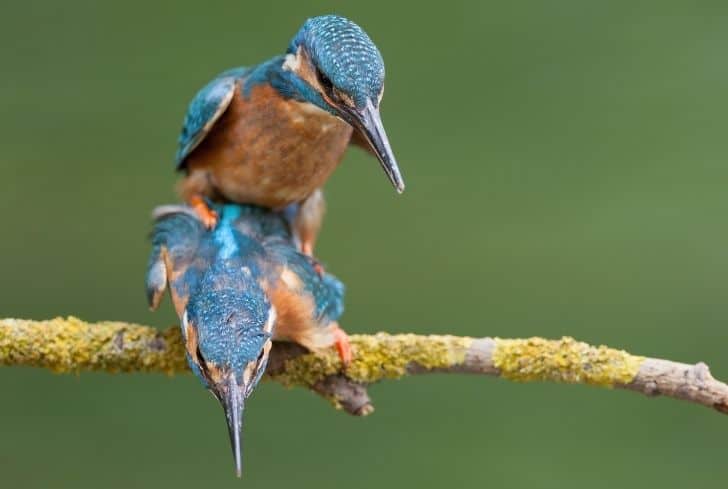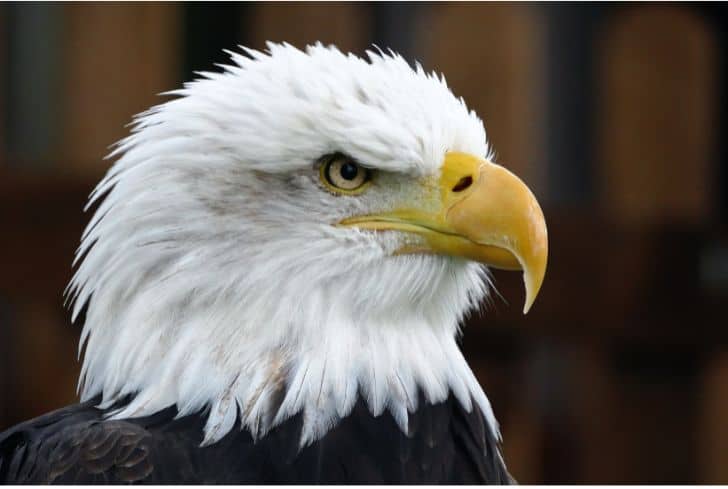Can Birds Fly Above the Clouds? (And in the Rain?)

There are around 10,000 different species of bird. A bird flaps its wings up and down to move forward and achieve lift. There are various ways it flaps its wings. What are they called?
Pigeons fly straight while continuously flapping their wings. In contrast, brown-eared Bulbuls and wagtails fly in an undulating pattern like drawing a wave. Interestingly, the Common Kestrel remains stationary in the air, going neither forward nor upward, called “hovering.”
Another flight style is “gliding,” when a bird flaps its wings a little, spreads them wide, and flies straight like swallows and kites. And “soaring” is when a bird glides with its wings spread wide and passes into a rising air current.
Now the question is, are they capable of flying above clouds? How high can birds fly?Let’s know more interesting facts about their flight in this article.
Do Birds Fly Above the Clouds?
Some birds can fly above clouds, including frigate birds and eagles. Migratory birds are often cited for spending time above the clouds, unfortunately making them victims of airplane accidents. However, common pet birds avoid flying near the clouds and maintain a shorter altitude.
Not all birds have the ability to fly at high altitudes. Only a few birds can because they have particular adaptations that increase oxygen uptake, circulation, and utilization. Ruppell’s Griffon and Bar-headed Goose, Mallard Duck fall into this category.
Storm clouds cannot beat eagles. Hence eagles soar high into the sky to avoid the rain. Eagles can reach an altitude of 10,000 feet above sea level with ease.
High-altitude flight is not possible for all birds. Additionally, fog and low clouds reduce visibility during flight affecting birds’ orientation and disrupting other migratory behaviors (Alerstam 1990; Richardson 1990; Chiaradia et al. 2007). (e.g., Alerstam and Ulfstrand 1974).
How High Can Birds Fly?
Birds can fly higher as they become lighter. This is also because bird lungs can extract more oxygen from the air than mammal lungs can. The record flight was for a Ruppell’s Griffon, which was unfortunately sucked into a jet engine at 37,900 feet.
However, perhaps the most impressive altitude record was created by a flock of Whooper Swans, which was seen on radar arriving over Northern Ireland on migration and visually identified by an airline pilot at 29,000 feet.
Vultures sometimes rise over 10,000 feet to scan larger areas for food (and to watch the behavior of distant vultures for clues to the location of a feast).
During migration, birds gain altitude using prevailing winds, and many species fly at 2,000 to 5,000 feet or higher. For example, a bird may begin migration at about 5,000 feet and slowly climb to 20,000 feet.
Birds often rise to relatively great heights while migrating, possibly to avoid dehydration in the warmer air near the ground. In the Caribbean, migrating birds are mostly observed around 10,000 feet.
Highest Flying Birds
Ruppell’s Griffon Vulture — 37,000 feet
The griffon vulture is on record for reaching the highest altitude of 37,000 feet. However, the thinning air at high altitudes is not a problem for them as the Ruppell vulture has unique hemoglobin that creates an effective system for oxygen intake.
Crane — 30,000 feet
The crane can hit over 30,000 feet and has flown across the Himalayas. They are also known as the Eurasian crane, seen in Northern parts of Asia and Europe. It is a medium-sized bird, but its wingspan is between six and eight feet.
Bar-headed Goose — 29,000 feet
Native to Central Asia, the bar-headed goose can ascend to 29,000 feet, high enough to sail over Mount Everest. They perfectly adapt to high Himalayan peaks where air pressure drops dynamically. These geese also have a greater lung capacity than other species in the family.
Whooper Swan — 27,000 feet
This swan is a large bird of Southern Eurasia known for its whooping call and loves flooded grasslands, tundras, wetlands, ponds, and lakes. They have yellow and black bills and long necks. They head off to Germany, Britain, and Denmark in the colder months.
Alpine Chough — 26,500 feet
The alpine chough, birds of high mountains of Central Asia and Southern Europe, are also called yellow-billed chough for their bright yellow bills. It builds its nests at altitudes of 21,000 or more feet, and the alpine chough is the world’s highest nester.
Now the exciting part is when birds do not want to fly! Continue reading to discover more about birds and their flights.

Can Birds Fly in the Rain?
They can—but they usually choose not to. For example, birds may be seen flying short distances in poor weather. Most birds need to eat several times a day and fly short distances in the rain to find food, but most prefer staying in the shelter.
Rain makes it harder for birds to fly; therefore, birds are found sitting on tree branches or power lines during a storm. When it rains, pressure drops, and the air is less dense. As a result, there are fewer molecules, which makes flying harder. Moving through the sky in areas of low air pressure takes a lot of energy.
In 2010, a research team studied blood samples of birds living in a Costa Rican rainforest. They found that the birds had higher stress hormone levels on rainy days.
Can Birds Fly With Wet Wings?
A little rain doesn’t bother birds much. Many birds use the rain as a bath and then ruffle their feathers to get clean. However, things change a bit when the rains get heavy and frequent. When birds get full wet, including their wings, they face trouble lifting off to fly because of the damp wing feathers. However, once they get more dried, they become capable of flying properly.
But birds do not get all-wet quickly because their feathers are highly waterproof and water roll off of their feathers, protecting the skin beneath. Additionally, many birds produce oil that they can spread over their feathers to protect themselves from the rain.
This protection helps them to fly short distances in the rain to find food when required. But when it pours down heavily, it can soak through the feathers causing them to get cold and limiting their ability to fly.
Can Birds Fly Backward?
Over 99% of all bird species cannot fly backward. Birds that can slightly move back include flycatchers, warblers, egrets and herons using the fluttering method. The wing structure of most birds has strong muscles for pulling them downwards and weak muscles for moving upwards. These birds rely on the winds to move their wings upwards; without the help of the wind, most of them cannot fly backward.
The only bird that can fly backward is the Hummingbird, the smallest bird. It is the only bird that can fly backward and forward without relying on the wind. Moreover, they can fly forwards, sideways, and backward while also being capable of changing their in-flight direction.
They have a unique ball and socket joint at the shoulder that allows it to rotate its wings 180 degrees in all directions. A figure eight pattern is traced at the tips of the wings while rising up with the backward and forward wing strokes.
Amazingly, it can also perform various mid-air acrobatic maneuvers like diving and hovering over a place for an extended period. The backward flight is usually observed when these birds retreat from one flower to move to another.
Can Birds Fly Without Flapping Their Wings?
Scientists generally consider two types of flight in flying animals: flapping flight and soaring flight. Bret Tobalske, a bird flight expert at the University of Montana, said the difference can be compared to peddling a bicycle uphill versus coasting downhill, who was not involved in the study.
For birds that can fly without flapping their wings, the sky is a landscape of invisible features such as wind gusts, currents of warm rising air, and streams of air pushed upward by ground features such as mountains. Riding air currents allows them to travel long distances while minimizing the exertion of flapping their wings.
The Andean condor, the heaviest soaring bird, is alive today with a wingspan stretching to 10 feet and weighing up to 33 pounds. Yet, these birds spent just 1% of their time aloft flapping their wings, mostly during take-off. One bird flew for more than five hours without flapping its wings, covering more than 100 miles (160 km). The results were published in the Proceedings of the National Academy of Sciences.
The Andean condor’s extreme skill at soaring is essential for its scavenger lifestyle. It requires hours a day of circling high mountains looking for a meal of carrion, said Sergio Lambertucci, a study co-author and biologist at the National University of Comahue in Argentina. In past studies, white storks and osprey flap for 17% and 25% of their overland migratory flights.
Why do Birds Not Fly at Night?
Most birds lack rod cells responsible for night vision, so they cannot see objects clearly in less or dim light due to the absence of these cells. This is why birds fly back to their nest in the evening. A diurnal bird avoids flying at night unless provoked, distressed, or in danger.
However, nocturnal birds like owls specialize in flying at night. This is because their bodies are tuned to perceive the sounds and sensations that prey makes at night. Characteristics such as muted plumage body colors, large complex eyes to pick out night-time prey movements, and enhanced smell and hearing senses make them fly at night and hunt.
Diurnal birds can be active during the night in certain conditions. For example, night migration is an activity in which many diurnal birds participate, like sparrows and thrushes. Likewise, small birds sometimes perform night migration to avoid dangerous predators like eagles and hawks, who are active solely during the day.
Conclusion
Birds will fly may be high or low according to their type as they need to search for food, shelter, and feed their young. Still, they sometimes restrict their flight as they can sense many future events, like an upcoming storm. As a result, these creatures can predict nature far better than humans. So, studying birds tells a lot many things!






